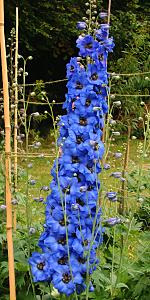 OBJECTIVES AND METHODS
OBJECTIVES AND METHODS| Return to Introduction | Return to Home Page |
Delphiniums from Seed 1Breeding delphiniums with Blue flowers |
 OBJECTIVES AND METHODS
OBJECTIVES AND METHODS
In breeding blue delphiniums we try to obtain attractive flowers with clear colour, well-formed florets of large size and regularly packed, tapering blooms on plants of short to medium height.
The picture here shows the first bloom of a seedling grown in 2002 that set our pulses racing and persuades us to keep searching for still better flowers.
We rely mainly on crosses made between seedlings of our own raising when breeding blue delphiniums. The seedling shown here, for example, is from a cross between a short-growing blue with a white eye and a late-flowering gentian blue with a black eye. The objective was to obtain mid-blue flowers with black eyes on plants of short or medium height. Typically, we grow about 30 seedlings of a cross and, in this case, four plants were considered worth retaining for a second look in 2003.
This page is divided into two main sections
SEEDLINGS GROWN IN 2002
Seedlings raised from hand-pollinated seed sown in February flowered in late summer from August to October. Four crosses were grown, each having a different objective, as follows:
Light Blues with White Eye The cross used was made between sister plants that both had light blue flowers with white eye and a short/medium height growth habit. Many of the initial batch of seedlings were lost due to damping off but a second sowing was more successful. With the second batch, losses occurred after planting that seemed to be caused by a soil pest (possibly crane fly larvae?).
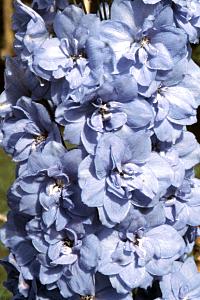 |
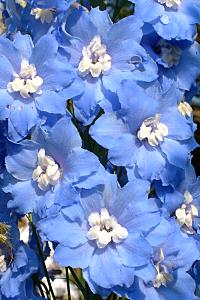 |
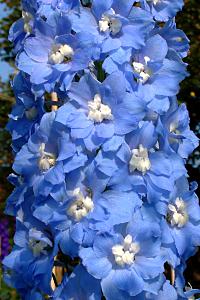 |
With the exception of one seedling with rather untidy eyeless double flowers shown in the left hand picture above, all seedlings had light blue flowers with white eyes, as seen in the centre and right hand pictures. The plants were mainly rather small but overall flower quality seemed low, many florets having malformed sepals giving a rough appearance to blooms. Few plants of this cross were considered worth retaining.
Deep Blue Flowers with White Eye on Short Plants To achieve this objective, the cross used was again between sister plants that both seemed to have the required characteristics. However, the flowers of the seedlings were quite different from what was expected. Only half the seedlings had the expected blue flowers with white eyes. The remainder had flowers in violet shades with a white eye, as seen in the pictures below. The other feature was that the blooms were extremely narrow.
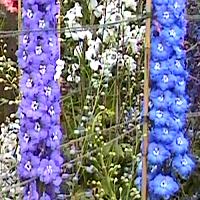 |
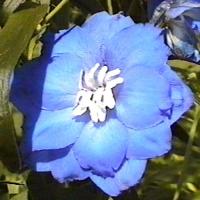 |
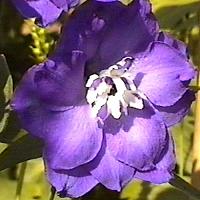 |
A possible explanation for this unexpected colour mixture is that both parents of the cross have a triple dose of a recessive gene associated with the violet colouration that has been inherited from the violet-flowered cultivar 'Cinderella', which had been used in the breeding line several generations in the past. This cross thus represents another blind alley, except that one of the seedlings with clear violet flowers was considered worth retaining.
Deep Blue Flowers with Black Eyes The batch of seedlings grown was from a cross between a plant that has light gentian blue flowers with black eyes and one parent of the seedlings described in the previous section that has mid blue flowers with a white eye. These plants are not closely related.
Eye colour is such a prominent feature of a delphinium flower that it would be interesting to know if a black eye is genetically the dominant character, with white being recessive, or vice versa. Going back over several generations, all plants used in breeding the white-eyed seed parent had white eyes, while all plants used in breeding the black-eyed pollen parent had black eyes. It is tempting to think that the selections over the generations might have resulted in plants that are true-breeding for eye colour. This is probably rather unlikely because plants with white eyes occurred at low frequency (10%) in each group of seedlings in the breeding line from which plants with black-eyed flowers were selected. However, if the parents were true-breeding for eye colour, this cross might produce a group of seedlings all having the same eye colour, either white or black depending on which is the dominant form.
Inheritance in delphiniums seldom seems to be so simple and the actual result was that one third of the seedlings that bloomed had the desired black eye, with the rest having white eyes. Some examples of the flowers are seen in the pictures below.
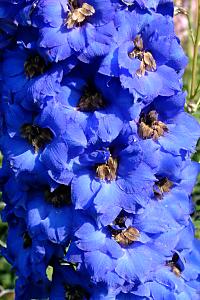 |
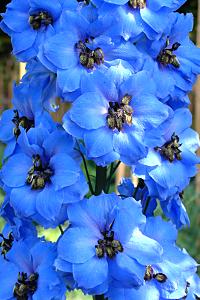 |
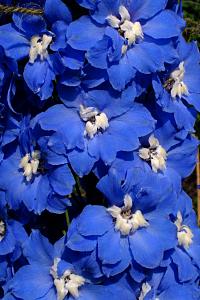 |
Two or three of the blues with black eyes will be retained. One seedling with flowers having a white eye, but especially brilliant gentian blue colour, is also being kept.
Deep Blues from 'Faust' The plant with white-eyed mid blue flowers used in the previous two crosses was also crossed to 'Faust' to explore whether this old cultivar might provide some deeper blues, despite our reservations about the floret form and very tall growth habit.
An initial problem was poor germination of the seed. Eight weeks after sowing, when pricking out seedlings of the cross involving 'Faust', 19 freshly germinated seedlings were found, which represented 48% of the seeds sown. The mid-blue seedling crossed to 'Faust' was from a cross that also showed delayed germination, so this tendency is presumably an undesirable inherited characteristic. Fortunately, the late germinating seedlings grew quickly and all these plants flowered.
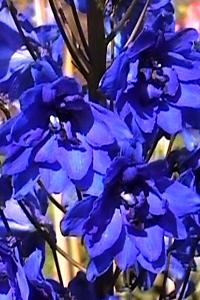 |
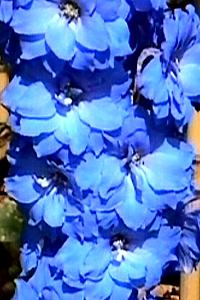 |
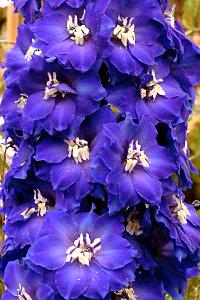 |
There was a fascinating range of colours and floret form among the seedlings. It was almost as though the clock had been turned back to about 1960, when Blackmore & Langdon introduced 'Faust' and a number of other well known cultivars. One tiny plant closely resembled 'Blue Tit' in form and colour, another was like gentian blue 'Fenella', while two others had intense violet flowers with white eyes comparable to 'Chelea Star'. The most surprising thing was that several plants had light blue flowers.
Looked at critically, the form of blooms and florets left much to be desired, although a few plants had sufficiently interesting flowers to deserve a second assessment. Even if nothing comes of such a speculative cross, the flowers of the seedlings were fascinating and provided all the elements of surprise and colour brilliance that encourage us to continue hybridising delphiniums.
| Return to Breeding Objectives | Return to Home Page |
BLUES FROM PREVIOUS YEARS
Seedlings from 1999 A batch of 42 seedlings was grown in 1999 from a cross between 'Galileo' [see "Summerfield Delphiniums" pages] and a mid-blue seedling. There was a range of colours from very pale greeny blues to gentian blues with both dark and light eyes. A small selection of the plants was retained and moved to new sites in spring 2000. A heavy mulch of leaf mould helped the plants to establish quickly and they produced blooms of excellent quality, especially considering how recently they had been moved. Two of these are seen in the left hand picture below. The light blue was discarded susequently but the dark blue plant remains and was in full bloom at the end of May 2002, as seen in the right hand picture. This is a useful garden plant of medium height that flowers early.
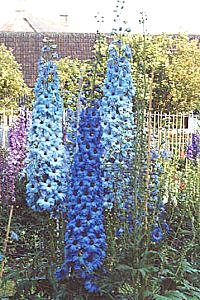 |
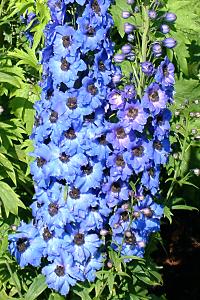 |
A group of seedlings from a cross labelled 99/18 that flowered in August-September 2000 provided several interesting short-growing plants having mid-blue flowers with white eyes and two light blues of good form were also selected.
Retained Blue Seedlings in 2001 Selected seedlings form cross 99/18 were transplanted to new sites in February but the weather conditions during the spring of 2001were unfavourable for root establishment.
In early June, most plants that had been moved still looked feeble with small leaves and these blues looked unbelievably short. An overnight deluge then dumped 50mm (2 in) of rain on the garden, which restored the soil moisture levels and brought about a miraculous transformation in the plants. The blue seedlings then grew vigorously and provided a good display. A thick layer of leafmould applied as a mulch helped maintain the plants in good condition during the dry spells in May and June. The soil around the roots remained quite moist, even though the bed of blue seedlings received hardly any watering with a hosepipe! In other areas of the garden our clay soil dried out and networks of 30mm wide cracks developed. These conditions were repeated in 2002!
The seedlings retained from cross 99/18 remained compact plants. The pale blues grew less well and developed only short spikes but with florets of good quality.
Flowers of the mid-blue seedlings showed varying degrees of pink flush over the blue but the colour of several plants was exceptionally pure and bore comparison with that of the ultimate standard variety 'Blue Nile'. The normal procedure for testing if a bloom is identical to a known cultivar, or is distinct, is to insert a floret of the known cultivar in the bloom. The result of adding a floret of 'Blue Nile' to one of the seedlings is seen here.
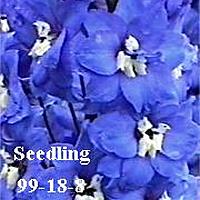 |
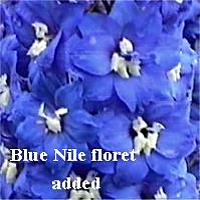 |
It is gratifying to find such a close colour match, especially as the plants have well packed blooms 0.75 m or more in length on plants not exceeding 1.5 m in total height. Like the parents, these seedlings are prolific sources of pollen and further crosses were made. In fact 99/18-8 was a parent in three of the crosses for blue grown in 2002 for which the results are described above.
As 'Blue Nile' is widely regarded as erratic, we hoped that at least one of our seedlings would make a more reliable garden plant but that looks to be over optimistic as the performance of the plants in 2002 suggests.
June/July 2002 Attention concentrated on two aspects of seedlings retained from previous years.
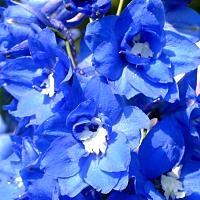 Plant Height. In early May, it appeared likely
that plants in their third year would be even shorter
than previously, when they grew to about 1.2m (4ft).
After substantial rain in late May, however, most shot up
to 1.5m or more (4.5 - 5.5ft). This emphasises the
problem of specifying the 'normal' height to which a
delphinium cultivar will grow.
Plant Height. In early May, it appeared likely
that plants in their third year would be even shorter
than previously, when they grew to about 1.2m (4ft).
After substantial rain in late May, however, most shot up
to 1.5m or more (4.5 - 5.5ft). This emphasises the
problem of specifying the 'normal' height to which a
delphinium cultivar will grow.The loss during the season of a number of retained seedlings as a result of crown rot is another setback. The most important loss was of a blue cultivar raised in 1991 from a cross having Loch Lomond as one parent. This plant had mid blue flowers with a white eye and was one parent of the group of short-growing blues raised in 2000. We have not previously suffered many losses from rotting of crowns and had neglected to propagate this particular plant. Clearly the clay soil and wet weather are factors favouring crown rot but we do not fully understand this disease problem.
| Return to Breeding Objectives | Return to Home Page |